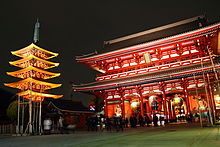This articleneeds additional citations forverification.(March 2023) |
Asakusa(Bụi cỏ,Japanese:[asakꜜsa]ⓘ)is a district inTaitō,Tokyo,Japan. It is known for theSensō-ji,a Buddhist temple dedicated to thebodhisattvaKannon.There are several other temples in Asakusa, as well as various festivals, such as theSanja Matsuri.



History
editThe development of Asakusa as an entertainment district during theEdo periodcame about in part because of the neighboring district, Kuramae. Kuramae was a district of storehouses for rice, which was then used as payment for servants of the feudal government. The keepers (fudasashi) of these storage houses initially stored the rice for a small fee, but over the years began exchanging the rice for money or selling it to local shopkeepers at a margin.[1]Through such trading, manyfudasashicame to have a considerable amount of disposable income and as result theaters andgeisha housesbegan to spring up in nearby Asakusa.
For most of the 20th century, Asakusa remained a major entertainment district in Tokyo. Therokkuor "Sixth District" was in particular famous as a theater district, featuring famous cinemas such as theDenkikan.The golden years of Asakusa are vividly portrayed inYasunari Kawabata's novelThe Scarlet Gang of Asakusa(1930). The area was heavily damaged by US bombing raids during World War II, particularly the10 March 1945 firebombing of Tokyo.The area was rebuilt after the war, but has now been surpassed byShinjukuand other colorful areas in the city in its role as a pleasure district.
Asakusa was a ward ofTokyo City.In 1947, when the city was transformed into ametropolis,it was merged withShitayato form the modern Taito ward. The former ward encompassed 19 neighborhoods in the eastern half of Taitō.
Geography
editAsakusa is on the north-east fringe of central Tokyo, at the eastern end of theTokyo Metro Ginza Linesubway, approximately one mile east of the majorUenorailway/subway interchange. It is central to the area colloquially referred to asShitamachi,which literally means "low city," referring to the low elevation of this old part of Tokyo, on the banks of theSumida River.As the name suggests, the area has a more traditionally Japanese atmosphere than some other neighborhoods in Tokyo do.
Food and drink
editAsakusa has many restaurants and places to try traditional Japanese foods. One of the most popular treats issatsuma imo,sweet potatoes. Another special treat ischikuwa kamaboko,grilled fish cakes. The Suzuhiro store serves local craft beer with traditionalkamaboko.Asakusa is also known for spices such asshichimiandsanshō.
In a city where there are very few buildings older than 50 years because of thewartime bombing,Asakusa has a greater concentration of buildings from the 1950s and 1960s than most other areas in Tokyo do. There are traditionalryokan(guest-houses) and small-scale apartment buildings throughout the district.
In keeping with a peculiarly Tokyo tradition, Asakusa hosts a major cluster of domestic kitchenware stores onKappabashi-dori,which is visited by many Tokyoites for essential supplies. Next to theSensō-jitemple grounds is a small amusement park calledHanayashiki,which claims to be the oldest amusement park in Japan. The neighborhood theaters specialize in showing classic Japanese films, as many of the tourists are elderly Japanese.
Cruises down theSumida Riverdepart from a wharf a five-minute walk from the temple.
Asakusa is Tokyo's oldestgeishadistrict, and still has 45 actively working geisha.[citation needed]
Because of its colourful location, downtown credentials, and relaxed atmosphere by Tokyo standards, Asakusa is a popular accommodation choice for budget travelers.
Carnival
editThe neighborhood is famous for its annual Brazilian stylecarnival.There is a significant Brazilian presence in the local community and the Association ofSamba Schoolsof Asakusa is based there.[2][3]
Sanja Matsuri
editAlthough there are many festivals throughout the year in Asakusa, the most famous of them is theSanja Matsuri,also known as Sanja Festival, which takes place in May.[4]In this festival,mikoshi(portable shrines) and floats are pulled through the streets while loud shouts accompany them, and during the festival's 3 days, 1.5 million people come out to celebrate.[5]
Transportation
editThe district has two railway stations with the same name:
- TSTobu Skytree Line(TS-01)
- AToei Asakusa Line(A-18)
- GTokyo Metro Ginza Line(G-19)
- Tsukuba Express(TX-03)
Education
editTaitō City Board of Education operates public elementary and junior high schools.
Asakusa 1-chomeand portions of 2-chomeare zoned toAsakusa Elementary School.All of 6- and 7-chomeand parts of 3-, 4-, and 5-chomeare zoned toFuji Elementary School.Parts of 3-, 4-, and 5-chomeare zoned toSenzoku Elementary School.Portions of 2-chomeare zoned toKinryu Elementary School.Portions of 5-chomeare zoned toHigashi-Asakusa Elementary School.[6]
Asakusa 1- and 2-chomeare zoned toAsakusa Junior High School.All of Asakusa 6- and 7-chomeand portions of 3-, 4-, and 5-chomeare zoned toSakurabashi Junior High School.Portions of Asakusa 3-, 4-, and 5-chomeare zoned toHakuyo Junior High School.[7]
In art and literature
edit- Kawabata Yasunari,The Scarlet Gang of Asakusa(1930)
- Kankichi Ryotsu, protagonist of the popular anime and manga seriesKochiKame,is born in Asakusa.
- "Corn Dog," season 1, episode 2 ofMidnight Diner, Tokyo Stories,a Netflix original series (2016), is about an old comedian who works in Asakusa and his successful young protégé.
- The animeSarazanmaiis set in Asakusa.
- In the anime and manga seriesFire Force,Asakusa shows up as the district under the jurisdiction of the Special Fire Force Company 7 and is the setting of the Asakusa arc.
- In the popular anime and manga series,Demon Slayer,chapters 14–17 and episodes 7–10, the primary location is Taishō-period Asakusa.
See also
edit- Asakusa Culture Tourist Information Center
- Asakusa Shrine
- Hanayashiki,oldest amusement park in Japan.
- Hōzōmon
- Kaminarimon
- Kiuchi Kyō
- Luna Park, Tokyo
References
edit- ^"Asakusa: The Heart of Old Tokyo".furthereast.Archived fromthe originalon 2015-04-03.Retrieved2015-03-06.
- ^Tamborins.br (in Portuguese)Archived2007-10-09 at theWayback Machine
- ^"Senso-Ji Temple-Tokyo: 5 Top Amazing Attractions Places To Visit".Archived from the original on 23 September 2020.Retrieved12 May2020.
- ^"About Asakusa – Tokyo Travel Guide | Planetyze".Planetyze.Retrieved2017-06-17.
- ^"About Sanja Matsuri (Sanja Festival) – Tokyo Travel Guide | Planetyze".Planetyze.Retrieved2017-06-17.
- ^"Đài đông khu lập tiểu học giáo thông học khu vực biểu"(PDF).City of Taito.Retrieved2022-10-09.
- ^"Đài đông khu lập trung học giáo thông học khu vực biểu"(PDF).City of Taito.Retrieved2022-10-09.
External links
edit- Media related toAsakusaat Wikimedia Commons
- Tokyo/Asakusatravel guide from Wikivoyage